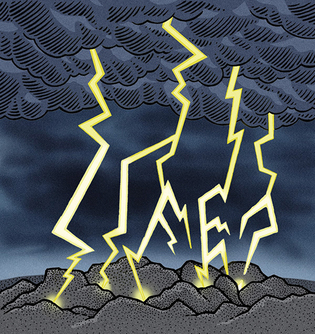 loading
loading
FindingsLightning and lifeDid life on earth get a jump start?  Gregory NemecView full imageBenjamin Hess, a graduate student in Yale’s Department of Earth and Planetary Sciences, was studying fulgurite—that reticulated glass that sometimes can be found in soil after a lightning strike—that had formed in the clay-rich earth in the flats of northern Illinois. While analyzing the fulgurite for the impact of thermal shock on minerals, Hess was surprised to discover large quantities of schreibersite, a rare mineral whose presence raised an intriguing possibility: might lightning strikes have been central to the rise of life on Earth? One of the fundamental elements of life as we know it is phosphorous. It forms the structural backbone of DNA and RNA; it is essential in the generation of cell membranes. And though phosphorous is abundantly present on Earth, most of it is inaccessible, chemically bound up in hard minerals. Schreibersite is different, because it carries phosphorous in a soluble form. When schreibersite gets wet, the phosphorous washes out and, with exposure to sunlight, can go on to form the foundational organic molecules from which life emerges. This, of course, raises a difficult question: where does schreibersite come from? He and two colleagues from the University of Leeds used computer models of Earth’s early atmosphere to estimate the number of annual lightning strikes that were occurring roughly 3.5 billion years ago, when life is believed to have emerged. This, in turn, provided an estimate of how much phosphorous lightning may have produced. The estimate—thousands of kilograms per year—was comparable to the amount of phosphorous produced by meteorites. Given favorable conditions, though, perhaps the seeds of life were carried down not from the stars, but from the clouds; not by meteorites, but by electricity.
The comment period has expired.
|
|